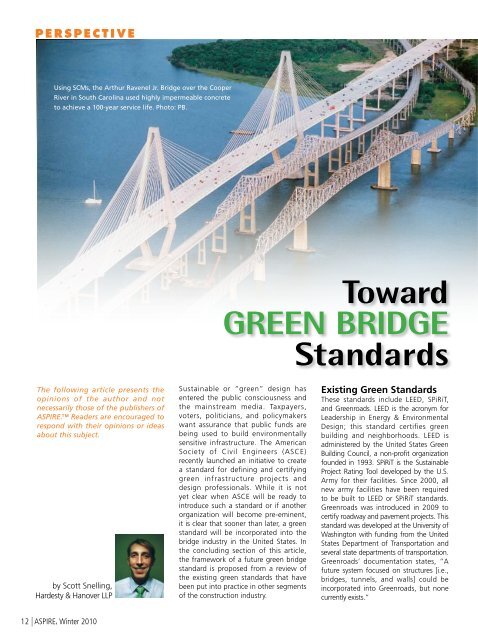ASPIRE Winter 10 - Aspire - The Concrete Bridge Magazine
ASPIRE Winter 10 - Aspire - The Concrete Bridge Magazine
ASPIRE Winter 10 - Aspire - The Concrete Bridge Magazine
Create successful ePaper yourself
Turn your PDF publications into a flip-book with our unique Google optimized e-Paper software.
PERSPECTIVE<br />
Using SCMs, the Arthur Ravenel Jr. <strong>Bridge</strong> over the Cooper<br />
River in South Carolina used highly impermeable concrete<br />
to achieve a <strong>10</strong>0-year service life. Photo: PB.<br />
Toward<br />
Green <strong>Bridge</strong><br />
Standards<br />
<strong>The</strong> following article presents the<br />
opinions of the author and not<br />
necessarily those of the publishers of<br />
<strong>ASPIRE</strong>. Readers are encouraged to<br />
respond with their opinions or ideas<br />
about this subject.<br />
by Scott Snelling,<br />
Hardesty & Hanover LLP<br />
Sustainable or “green” design has<br />
entered the public consciousness and<br />
the mainstream media. Taxpayers,<br />
voters, politicians, and policymakers<br />
want assurance that public funds are<br />
being used to build environmentally<br />
sensitive infrastructure. <strong>The</strong> American<br />
Society of Civil Engineers (ASCE)<br />
recently launched an initiative to create<br />
a standard for defining and certifying<br />
green infrastructure projects and<br />
design professionals. While it is not<br />
yet clear when ASCE will be ready to<br />
introduce such a standard or if another<br />
organization will become pre-eminent,<br />
it is clear that sooner than later, a green<br />
standard will be incorporated into the<br />
bridge industry in the United States. In<br />
the concluding section of this article,<br />
the framework of a future green bridge<br />
standard is proposed from a review of<br />
the existing green standards that have<br />
been put into practice in other segments<br />
of the construction industry.<br />
Existing Green Standards<br />
<strong>The</strong>se standards include LEED, SPiRiT,<br />
and Greenroads. LEED is the acronym for<br />
Leadership in Energy & Environmental<br />
Design; this standard certifies green<br />
building and neighborhoods. LEED is<br />
administered by the United States Green<br />
Building Council, a non-profit organization<br />
founded in 1993. SPiRiT is the Sustainable<br />
Project Rating Tool developed by the U.S.<br />
Army for their facilities. Since 2000, all<br />
new army facilities have been required<br />
to be built to LEED or SPiRiT standards.<br />
Greenroads was introduced in 2009 to<br />
certify roadway and pavement projects. This<br />
standard was developed at the University of<br />
Washington with funding from the United<br />
States Department of Transportation and<br />
several state departments of transportation.<br />
Greenroads’ documentation states, “A<br />
future system focused on structures [i.e.,<br />
bridges, tunnels, and walls] could be<br />
incorporated into Greenroads, but none<br />
currently exists.”<br />
12 | <strong>ASPIRE</strong>, <strong>Winter</strong> 20<strong>10</strong>

















